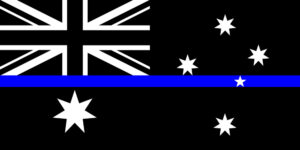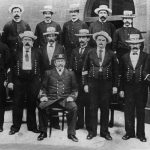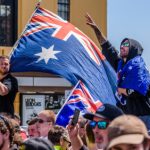Australian Police Officers Continue Signalling Their White Supremacist Allegiance

The Queensland Police Service is currently investigating a matter that involves a photo of one of its officers that appears to show him wearing a patch associated with white supremacist groups as he was policing a Black Lives Matter (BLM) protest in Brisbane last Friday.
The patch in question displays a US flag dissected by a blue line. Known as the thin blue line, this symbol shows a blue line crossing a nation’s flag, which indicates that law enforcement is the line that prevents society from descending into chaos.
This symbol started to take on racist overtones, when it was displayed alongside the Confederate flag during the August 2017 Unite the Right rallies in the US city of Charlottesville.
And while the thin blue line originates in the States, variations of its design involve the flags of the UK, Canada and Australia.
The BLM protest was in response to the death in custody of a 49-year-old Aboriginal woman in the Brisbane watchhouse. It’s the 440th First Nations custody death since 1991. And the officer’s patch is indicative of the BLM movement’s claim that the institution of police is founded upon racism.
Gesturing offence
Last week’s incident is the latest in a series involving Australian police officers indicating their adherence to white supremacist ideology.
The first occurred at last October’s blockade of the International Mining and Resources Conference in Melbourne.
At that time, a photograph emerged that showed Victoria police senior constable Travis Gray making the “OK” symbol with his fingers. Since 2017, this sign has been used by far-right groups, after it was co-opted on the 4chan website.
Initially, Victoria police outlined that Gray had no idea of the racist significance behind the gesture. However, days later, it became apparent that the senior constable would have been well aware considering his Facebook page was awash with right-wing imagery.
Founded on racism
The suggestion that an officer at a climate rally could have made an honest mistake in not knowing that the OK sign had taken on racial overtones was conceivable. But following the national outcry it led to, it wasn’t so easy to excuse a NSW police officer from giving the same gesture at a BLM rally.
On 12 June this year, Black Lives Matter protesters gathered in Sydney’s Hyde Park and at Town Hall. At that period, the awareness that the BLM movement was confronting the systemic racism of law enforcement, as well as the broader criminal justice system, was front and centre.
On that evening, NSW police officers were specifically surrounding the Captain Cook statue in Hyde Park to protect it against demonstrators who might target it as a symbol reflecting the racist foundations that underpin modern Australia.
So, when a group of NSW police officers marched down from Hyde Park towards Town Hall, and one of them took the opportunity to make the OK hand sign in the direction of a protester who was filming them crossing Pitt Street, no one was suggesting he was unaware of what he was doing.
Indeed, while many in the community are none too surprised that there are racists in the ranks of Australian police forces, what they might be caught out by is a growing tendency amongst officers to openly display their prejudice in public.







